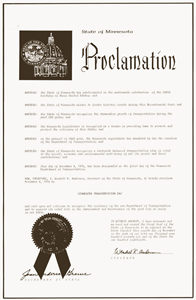 |
|
A proclamation signed
by former Gov. Wendell Anderson announced Nov. 8, 1976, as Transportation
Day to commemorate the creation of Mn/DOT.
|
Like most births, the start of Mn/DOT 25 years ago created
some anxiety, some joy and a measure of hope for the future.
Mn/DOT was created by combining the former Department of Highways, the Department
of Aeronautics and parts of the State Planning Agency and the Department of
Public Service. The newly formed department’s charge was to create a multi-modal
system to meet the state’s growing transportation needs.
The change was not an easy one. Mn/DOT’s history and identity
rested on building and maintaining highways. In fact, the Transportation Building
in St. Paul was expanded by two floors as it was being built to meet the needs
of the interstate system’s designers and managers.
Though committed for multi-modal service, the department’s
resources were committed overwhelmingly to highways, especially completion of
the interstate system in Minnesota.
The transition to a fully multi-modal department took some
doing. The process is still in the making, but the
results are beginning to show. For example, Minnesota will soon have its first
light rail transit line—the Hiawatha LRT in Minneapolis—and plans call for commuter
rail lines being established on existing rail routes such as the route between
St. Cloud and Minneapolis. The Hiawatha LRT will join large and small transit
systems, carpools, vanpools and other modes to meet state residents’ mobility
needs.
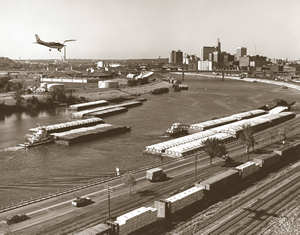 |
|
Mn/DOT
"official" multi-modal photo was taken in 1976 by Neil Kveberg,
Site Development Unit, from a bluff overlooking downtown St. Paul. The
skyline has changed, but the city remains a transportation hub.
|
While Mn/DOT was evolving from essentially a highway-only
agency to a multi-modal one, the department’s internal landscape also changed.
At the Transportation Building in St. Paul, open floors
with scores of drafting tables gave way to offices and cubicles crammed with
computers, plotters and other high-tech gear. District signs reflected the change
from highways to transportation department.
Once almost exclusively white and male in its technical,
professional and managerial ranks, Mn/DOT included growing numbers of women
and people of color. The annual selection of "Miss Minnesota Highways"
was dropped in 1981 as appreciation of women’s full potential value in the workplace
grew. Managers increasingly drew on employees’ knowledge, energy and expertise
to find solutions to problems.
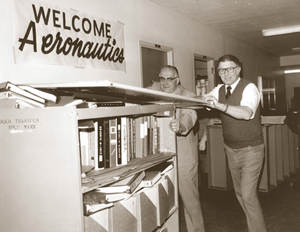 |
|
Lee Nelson, former
director of administration, and Larry McCabe, Mn/DOT’s first director
of aviation, move a box containing business essentials into the Transportation
Building, marking the former Department of Aeronautics inclusion in the new transportation department.
|
Programs such as quality circles and quality improvement
tapped employees’ creativity and vast store of common sense to find better ways
to do things. A series of intensive seminars, the Northstar Workshops, brought
Mn/DOT experts together with those from outside the agency to focus on crucial
issues.
Training opportunities for employees expanded with the appointment
of employee development specialists in the Central Office and each district.
Mn/DOT also expanded its collective knowledge by partnering
with other agencies and countries to share expertise and research findings.
Employee visits to foreign countries increased as
did delegations of visitors to Mn/DOT facilities.
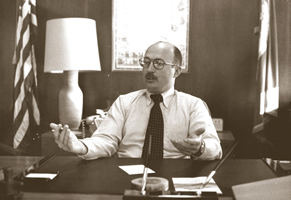 |
|
Jim Harrington, Mn/DOT’s
first commissioner, served from 1976 until 1979 when he was succeeded
by Dick Braun.
|
Developments such as the Minnesota Road Research Project,
which uses a part of I-94 near Monticello as a "real world" laboratory
to test pavement design and structure, cemented Mn/DOT’s
reputation for leadership and innovation.
Like an adolescent, Mn/DOT gradually became surer of itself
and its place in the world. The agency’s public affairs efforts took its message
to the public; its market research program provided
a guide to customer needs and expectations.
Twenty five years later, Mn/DOT has matured into a confident
yet still-learning agency eager to meet the demands of its customers. The department
has emerged as a credible advocate for a transportation system innovative and
flexible enough to meet the state’s changing needs.
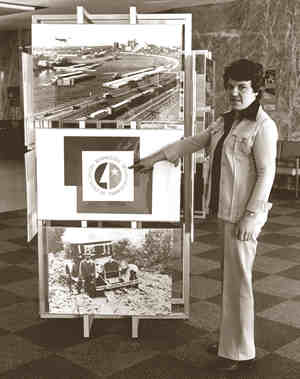 |
|
The late Millie Ehrich,
formerly of Communications and Public Relations, points out the new Mn/DOT
logo displayed in the lobby of the Transportation Building in St. Paul.
Ehrich served as receptionist until her retirement.
|
Marking the department’s 25th year, Commissioner Elwyn Tinklenberg
said, "On this, the silver anniversary of Mn/DOT, let’s make sure we continue
to prove our mettle as transportation leaders. Pure silver has a brilliant,
white metallic luster. Yet silver is very malleable and able to withstand change.
Mn/DOT was formed 25 years ago and it remains adaptable."
Adaptability by the department and its people remains key
to Mn/DOT’s past and future successes as it continues to mature and become an
even more effective leader and innovator in transportation in the 21st century.
By Craig Wilkins
|


